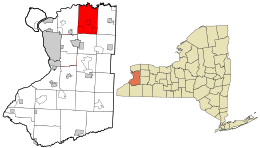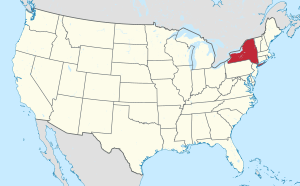Clarence, New York facts for kids
Quick facts for kids
Clarence
Tanumnogao (Wenrohronon)
|
|
|---|---|
| Town of Clarence | |

Clarence Hollow, the main district of Clarence
|
|

Location in Erie County and the state of New York.
|
|

Location of New York in the United States
|
|
| Country | |
| State | |
| County | Erie |
| Incorporated | 1808 |
| Founded by | Asa Ransom |
| Named for | Prince William, Duke of Clarence |
| Government | |
| • Type | Supervisor–council government |
| Area | |
| • Total | 53.63 sq mi (138.90 km2) |
| • Land | 53.50 sq mi (138.56 km2) |
| • Water | 0.13 sq mi (0.34 km2) |
| Elevation | 735 ft (224 m) |
| Population
(2020)
|
|
| • Total | 32,950 |
| • Density | 604.28/sq mi (233.32/km2) |
| Time zone | UTC-5 (EST) |
| • Summer (DST) | UTC-4 (EDT) |
| ZIP code |
14031, 14032, 14051*, 14221* (*= denotes part of western side)
|
| Area code(s) | 716 |
| FIPS code | 36-029-15825 |
Clarence is a town and a nice suburb located in the northeastern part of Erie County, New York. It's found northeast of the city of Buffalo. In 2020, about 32,950 people lived there. This was a 7.4% increase from 2010.
The town is named after Prince William, Duke of Clarence. He was the third son of King George III and later became King William IV. There are no separate villages within the town of Clarence.
Contents
Clarence: A Cool Town in New York
Clarence's Early History
The Native Americans who lived here long ago called this area Ta-Num-No-Ga-O. This name means "Place of Hickory Bark."
Clarence was the very first town created in Erie County in 1808. Many other towns, villages, and even cities were later formed from parts of Clarence. For example, the town of Buffalo (where the city of Buffalo started) was separated from Clarence in 1810. Later, Newstead, Alden, and Lancaster were also formed from Clarence.
This part of New York was once part of the Holland Purchase. When Genesee County was created in 1802, Clarence was part of it. Clarence and another area called Willink made up the entire region that would become Erie County in 1821.
One of the first settlers in Clarence was Asa Ransom, who arrived in 1799. He settled in the southeast part of town, which is now known as Clarence Hollow. In 1807, Asa Harris, a former officer from the American Revolution, opened a tavern in Harris Hill.
During the War of 1812, the printing press for the Buffalo Gazette newspaper was moved to Clarence. This kept it safe from British troops.
Later History and Cool Facts
By the late 1800s, industries like brick making, potash mining, and gypsum mining came to Clarence. Large companies like National Gypsum and Atlas Gypsum operated mines here in the 20th century.
Some people believe that Clarence is where the carrousel (merry-go-round) was first introduced to the United States! Two German immigrants brought carrousels to Clarence in 1879. Today, some parts of these original carrousels, including wooden horses, are kept at the Circus Hall of Fame in Sarasota, Florida.
The town celebrated its 200th birthday in 2008.
A Sad Day: Colgan Air Flight 3407 Crash
On February 12, 2009, Colgan Air Flight 3407 crashed in Clarence Center. This was a commuter flight from Newark to Buffalo. Sadly, all 49 people on board and one person on the ground passed away.
Clarence's Geography
Clarence covers about 138.9 square kilometers (53.6 square miles). Most of this area is land, with a small amount of water.
The northern border of the town is along Tonawanda Creek. This creek also forms the border with Niagara County.
Major roads in Clarence include New York State Route 5, known locally as Main Street, which crosses the southern part of town. NY Route 78, called Transit Road, forms the western border. The New York State Thruway (Interstate 90) is just south of Clarence.
Clarence is a mix of suburban areas, light industry, and farms. The town government offices are located in Clarence Center.
Neighboring Areas
Clarence is located northeast of Buffalo, west of Batavia, and south of Lockport.
The towns that share a border with Clarence are:
- Town of Amherst - to the west
- Town of Lockport, Niagara County - to the north
- Town of Royalton, Niagara County - to the northeast
- Town of Newstead - to the east
- Town of Lancaster - to the south
Main Roads in Clarence

 Interstate 90 (the New York State Thruway) goes through the very southeastern corner of Clarence.
Interstate 90 (the New York State Thruway) goes through the very southeastern corner of Clarence. New York State Route 5 (Main Street) is a major road that runs east-west through the southern part of town.
New York State Route 5 (Main Street) is a major road that runs east-west through the southern part of town. New York State Route 78 (Transit Road) runs north-south and marks the western edge of the town.
New York State Route 78 (Transit Road) runs north-south and marks the western edge of the town. New York State Route 324 (Sheridan Drive) is an east-west road that ends in Clarence at Main Street.
New York State Route 324 (Sheridan Drive) is an east-west road that ends in Clarence at Main Street.
People and Population
| Historical population | |||
|---|---|---|---|
| Census | Pop. | %± | |
| 1820 | 3,278 | — | |
| 1830 | 3,353 | 2.3% | |
| 1840 | 2,271 | −32.3% | |
| 1850 | 2,727 | 20.1% | |
| 1860 | 3,356 | 23.1% | |
| 1870 | 3,147 | −6.2% | |
| 1880 | 3,495 | 11.1% | |
| 1890 | 3,195 | −8.6% | |
| 1900 | 2,948 | −7.7% | |
| 1910 | 2,991 | 1.5% | |
| 1920 | 2,660 | −11.1% | |
| 1930 | 3,208 | 20.6% | |
| 1940 | 4,426 | 38.0% | |
| 1950 | 6,331 | 43.0% | |
| 1960 | 13,267 | 109.6% | |
| 1970 | 18,168 | 36.9% | |
| 1980 | 18,146 | −0.1% | |
| 1990 | 20,041 | 10.4% | |
| 2000 | 26,123 | 30.3% | |
| 2010 | 30,673 | 17.4% | |
| 2020 | 32,950 | 7.4% | |
| U.S. Decennial Census | |||
In 2000, there were 26,123 people living in Clarence. About 38.6% of households had children under 18. The average household had 2.80 people.
The median age in the town was 40 years old. This means half the people were younger than 40 and half were older.
The median income for a household in Clarence was $88,003. This means that half of the households earned more than this amount, and half earned less.
Communities and Places in Clarence
Main Communities
- Clarence (also called "Clarence Hollow" or "The Hollow") is in the southeast. It's a large community with homes and businesses. The Clarence Historical Society is located here.
- Clarence Center is near the middle of the town. It's a small community with many homes around Goodrich Road and Clarence Center Road. The town government offices are located here.
- East Amherst is a community on the west side of town, mostly in the town of Amherst.
- Harris Hill is a large community in the southwest corner of town, built on a small hill.
- Hunts Corners is a group of homes near the eastern town line.
- Millersport is a community in the northwest corner of the town. It extends into Amherst and across Tonawanda Creek into Niagara County.
- Rapids is a community at the northern town line. It's mostly in Niagara County but partly in Erie County.
- Swormville is on the western border of the town and also extends into Amherst.
- Wolcottsburg is a community in the northern part of the town with businesses, homes, and a church.
Natural Spots
- Beeman Creek is a small stream in the northeast that flows into Tonawanda Creek.
- Black Creek flows through the northern part of town and joins Tonawanda Creek.
- The Escarpment is a natural ledge or cliff that runs through the middle of the town.
- Spaulding Lake is a lake that used to be a quarry. It's now surrounded by an upscale housing area.
- Tillman Road Wildlife Management Area is a special area in the southeast part of Clarence for nature and wildlife.
Cool Places to Visit
- Museum of European Art – This museum has art by famous artists like Salvador Dalí and Pablo Picasso.
- Clarence Historical Society Museum – Here you can learn about the history of Clarence, including old railroads, model airplanes, and local inventions.
Education in Clarence
Most students in Clarence go to schools in the Clarence Central School District. This district has:
- One high school: Clarence High School
- One middle school: Clarence Middle School
- Four elementary schools: Clarence Center, Harris Hill, Ledgeview, and Sheridan Hill
Some parts of the town are served by the Williamsville Central School District.
There are also two Catholic elementary schools:
- Nativity of the Blessed Virgin Mary Church Elementary School in Harris Hill (Kindergarten to 8th grade, plus pre-school).
- St. Mary's School in Swormville (Kindergarten to 8th grade, with a Montessori program).
Famous People from Clarence
Many interesting people have lived in Clarence, including:
- Kevyn Adams: General Manager for the Buffalo Sabres hockey team.
- Dave Andreychuk: A famous hockey player who played for 24 years in the NHL.
- Joan Baez: A famous folk musician from the 1960s. She spent some of her childhood in Clarence Center.
- Martin Biron: A hockey goalie who played for the Buffalo Sabres.
- Jeff Glor: A well-known television journalist and news anchor.
- Neil Haskell: A top dancer from So You Think You Can Dance (Season 3) and an original cast member of the Broadway musical Hamilton: An American Musical.
- Chad Michael Murray: A TV and movie star who went to Clarence High School.
- John Neumann: The first American bishop to become a saint. He was an early priest at St. Mary's in Swormville.
- Joyce Carol Oates: A famous author.
- Jason Pominville: A retired professional hockey player.
- Lindy Ruff: A longtime player and head coach for the Buffalo Sabres.
- Patrick Wilson: The drummer for the band Weezer. He also attended Clarence High School.
Sister City
Clarence has a special connection with Tianjin, China. They became sister cities on November 10, 2001.
See also
 In Spanish: Clarence (Nueva York) para niños
In Spanish: Clarence (Nueva York) para niños

